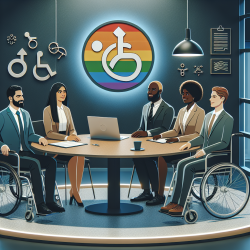Introduction
In today's diverse workplace, understanding the dynamics of disability disclosure is crucial for creating inclusive environments. A recent study titled "Diversity and Inclusion in the Legal Profession: Disclosure of Cancer and Other Health Conditions by Lawyers with Disabilities and Lawyers Who Identify as LGBTQ+," offers valuable insights into the factors influencing disclosure decisions. This blog explores how practitioners can apply these findings to improve their skills and foster more inclusive workplaces.
Understanding Disability Disclosure
The decision to disclose a disability in the workplace is deeply personal and influenced by various factors, including the visibility of the disability, its onset, and the individual's need for accommodations. The study highlights that lawyers with less visible disabilities, such as mental health conditions, are less likely to disclose their status compared to those with more apparent disabilities. This reluctance is often due to the stigma associated with invisible disabilities.
Key Findings and Implications
Here are some key findings from the research that practitioners should consider:
- Visibility of Disability: Individuals with visible disabilities are more likely to disclose, suggesting that stigma plays a significant role in the decision-making process.
- Accommodation Requests: Lawyers who have requested accommodations are more willing to disclose, but primarily to co-workers and management, not clients.
- Gender Differences: Women are less likely to disclose to management and clients, indicating potential gender-based barriers in disclosure practices.
- Age and Parenthood: Older attorneys are more likely to disclose to clients, while those with children are less likely to disclose to co-workers.
- Organizational Culture: An inclusive workplace culture and the presence of co-workers with disabilities are associated with higher disclosure rates.
Practical Applications for Practitioners
Practitioners can enhance their skills by implementing the following strategies based on the research findings:
- Promote an Inclusive Culture: Foster a workplace environment that encourages openness and acceptance. Training programs should focus on reducing stigma and increasing awareness about invisible disabilities.
- Encourage Accommodation Requests: Create clear channels for employees to request accommodations without fear of negative repercussions. This can be achieved by ensuring confidentiality and providing support throughout the process.
- Address Gender and Age Disparities: Implement targeted interventions to support women and older employees in disclosing disabilities. This could involve mentorship programs and peer support networks.
- Leverage Diversity: Encourage diversity at all levels of the organization to create role models and allies for employees with disabilities.
Conclusion
Understanding the complexities of disability disclosure is essential for practitioners aiming to create inclusive workplaces. By applying the insights from this study, practitioners can enhance their skills and contribute to a more supportive environment for individuals with disabilities. For those interested in further research, the original study offers a comprehensive analysis of these dynamics.
To read the original research paper, please follow this link: Diversity and inclusion in the legal profession: disclosure of cancer and other health conditions by lawyers with disabilities and lawyers who identify as LGBTQ+?










